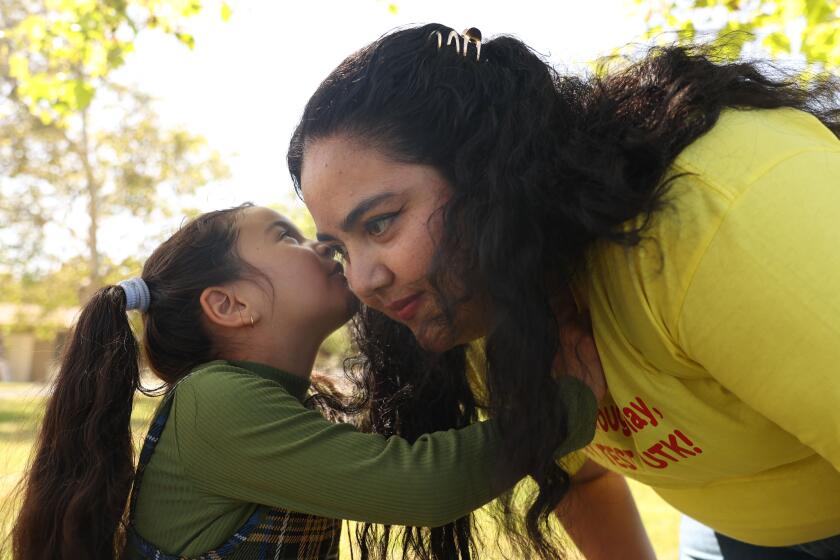Children’s welfare demands that the incompetence stop
I’m tired of hearing “culture change” held out as a fix for idiocy.
That’s the standard excuse when institutions fail: A dysfunctional culture is to blame when students don’t learn or jail inmates are beaten.
And it’s the explanation being offered up in the latest example of tragic incompetence by the Los Angeles County foster care system: the death of 8-year-old Gabriel Hernandez, who police say was tortured and killed by his mother and her boyfriend.
The child was on social workers’ radar for months. Teachers and relatives had reported his bruises, black eye, busted lip. But not even a therapist’s discovery of the third-grader’s suicide note was enough to convince social workers that he might be in danger at home.
What kind of culture says it’s OK to leave a frightened child in such a perilous situation?
That’s the question I put to Philip Browning, who heads the Department of Children and Family Services and has been trumpeting “culture change” since he took the reins early last year.
Browning admitted that even he is stumped by how this tragedy unfolded.
“You can see where someone should have done something, and you can’t imagine why they didn’t,” he said.
Four social workers have been taken out of the field while the county investigates. But the department has a terrible track record in holding employees accountable for mistakes and misdeeds. In 15 earlier deaths of children linked to social worker errors, only one employee was terminated -- for falsifying records.
That part of the culture clearly does need changing. But it’s only the tip of the iceberg in a department riddled with dysfunction.
::
Social workers’ union exec David Green said his phone hasn’t stopped ringing since Gabriel’s death made news two weeks ago. “I can’t tell you how many calls I’ve gotten from crying social workers who submitted their letters of resignation because of what’s going on,” he said.
They’re heartbroken over the tragedy, but they’re also worried about what comes next: “There’s a climate of fear in this department,” Green said. “People’s first reaction is always ‘fire the social workers.’ ”
So what’s wrong with that?
Green told me social workers are victims, too, of a department strangled by knee-jerk edicts, conflicting rules and a paralyzing workload.
“It’s really difficult to make good decisions when you have triple the cases [you should], 6,000 policies to follow and fear of doing the wrong thing,” said Green, a social worker for 13 years.
But department chief Browning said the problem goes even deeper than that. Social workers feel hamstrung by a departmental obsession with keeping children with their families, given the shortage of good foster homes.
That policy was the product of a previous culture change, aimed at reducing foster care rolls and strengthening troubled families with resources like drug treatment, mental health care and parenting classes.
But Browning said it has “immobilized” social workers, who rely on mindless allegiance to the goal instead of “common sense and critical thinking” about what’s best for children.
“Social workers have said they feel pressured to leave kids with families,” Browning said. “But safety of the child should be the primary goal.”
He plans to get that message across by disciplining social workers who screw up in obvious and avoidable ways. And by giving them permission to rely less on the rule book and more on the question: “Would you leave your own child in this setting?”
“If you can walk away and feel your child would be safe, that’s good. But if you have a sick feeling in your stomach, go back. Get more information. Talk to your supervisor. Ask yourself, what else can we do?”
::
I had to stifle my anger over Gabriel’s death even to listen to Browning. But I have to admit that I’m encouraged by his perspective.
I understand that social workers may consider it naive. “What you’re taught in Social Work 101 is to have good boundaries,” said Green, the union rep. Treating every child like your own can break your heart and complicate your job.
But it’s a mind-set that ought to be fundamental, not just in caring for neglected children but in reforming a department that seems designed to court disaster.
The toughest decisions are often left to the least experienced workers. Emergency responders juggle high caseloads, work long hours and deal with volatile families. And, until Browning arrived last year, they relied on virtually useless training and primitive technology.
“We used to take everybody who walked in the door,” Browning said. Training was two months of lectures and nobody flunked. Once in the field, social workers were saddled with antiquated cellphones, “the size of a brick,” that couldn’t email or text. Van drivers ferrying children were relying on Thomas Guides.
Now, Browning said, only half of social work applicants make the cut. A new year-long training program gives them more experience in the field before they get caseloads. And iPhones have made paperwork more efficient so they have more time to tend to kids.
That’s part of the cultural change he says will pay dividends in the future. But it doesn’t make me feel any better about the death of Gabriel Hernandez.
Clearly what happened to that child is bigger than a few social workers who failed to do their jobs. But there’s a wisdom to the public clamor that someone be singled out and flogged.
You reset a culture not through practical changes or philosophical edicts, but by what you punish and reward. What you overlook and what you allow speaks volumes to your troops.
I want to know who did what wrong, and I want heads to roll.
--
More to Read
Start your day right
Sign up for Essential California for news, features and recommendations from the L.A. Times and beyond in your inbox six days a week.
You may occasionally receive promotional content from the Los Angeles Times.






